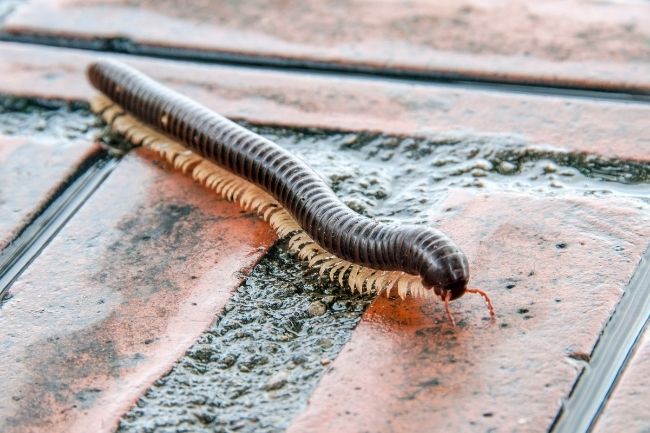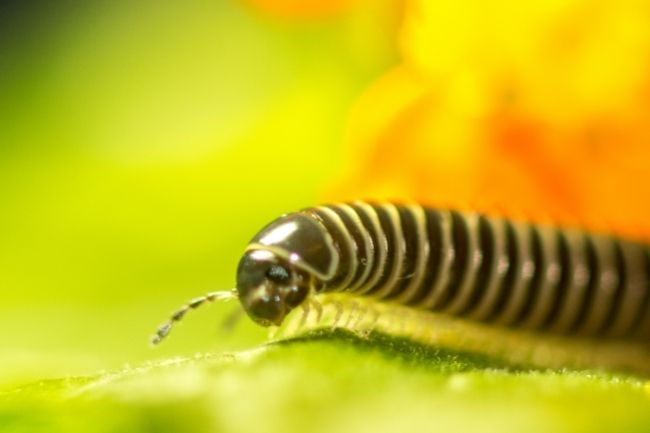Millipedes are not insects, though they are often referred to as one. Instead, they are part of the Myriapoda, a group that also includes centipedes.
Contents
What is an insect?

We tend to think of insects as being anything small that creeps through the undergrowth or flies through the air, however, scientifically there are very specific features we look for to categorise an animal like an insect.
Firstly, insects have bodies that are divided into three segments, the head, the thorax and the abdomen. The head is where the eyes, mouth and set of antennae are located, while the legs and wings are connected to the thorax. The abdomen contains the reproductive organs as well as most digestive organs.
In many insects, these divisions aren’t always easy to spot, as the thorax or abdomen can be subdivided into additional sections.
Insects will also have three paired and segmented limbs, meaning they have six legs in total. Segmented simply means that these limbs have joints that allow them to bend and move. It’s this that stops us from grouping spiders with insects, as they have four sets of legs.
As arthropods, insects also have exoskeletons, a hardened skin made of chitin, the same material as our fingernails. This exoskeleton protects them from attack but also helps to support their bodies and allow movement.
Despite having all these things in common, insects are a very wide and varied group, from ladybirds to butterflies to ants. They are found across all habitats and continents, having adapted themselves to all kinds of different conditions and lifestyles.
Also read: Are Ladybugs an Insect? (Explained)
Are millipedes an insect?

While millipedes are not insects, outside scientific circles they generally are grouped with a diverse group of ‘insect’ species.
There are around 12,000 species of millipedes globally, and as a group, they are one of the most ancient arthropod species.
Millipedes are a widely recognised group, with their long bodies and many legs. Their name derives from the idea that they have 1,000 legs, however, the majority of species have between 100 and 400 legs. One species, Eumillipes persephone, has been found to have 1,300 legs.
Most millipedes are detritivores, eating dead plant matter and fungus. Their shape is usually rounded; however, some species do have flattened forms.
| Characteristic | Insects | Millipedes |
|---|---|---|
| Number of Legs | Six | Many (ranging from 30 to over 400) |
| Body Segments | Head, Thorax, Abdomen | Numerous segments along the body |
| Antennae | Present | Present |
| Wings | Many species have wings | Most species do not have wings |
| Exoskeleton | Yes | Yes |
| Mode of Reproduction | Mostly Sexual (Some Asexual) | Mostly Sexual (Some Asexual) |
| Habitat | Terrestrial, Freshwater, and Air | Terrestrial, Moist Environments |
Like insects, millipedes have three body segments, a head, thorax and abdomen. These segments are hard for the non-expert to identify, as there is no clear delineation between the abdomen and the thorax.
As millipedes sit within the arthropods, like insects, they also share the hard outer exoskeleton. This helps to protect them from attacks by other invertebrates and gives support to their bodies.
Like insects, millipedes also have a set of antennae. These are important sensory organs, allowing the millipedes to pick up chemical signals that help them to find food and detect the presence of danger. Their eyesight is fairly poor, leading to a heavy reliance on their antennae to navigate.

So far so insect-like, however, this is where millipedes find their own way. Millipedes, unlike insects, have more than three pairs of legs, a feature they are famous for.
A millipede’s body is divided into many segments, the number varying depending on the species. Each of these segments has two sets of legs. This has come about through two segments fusing together in the past. The first few segments behind the head only have one pair of legs.
| Differentiating Factor | Insects | Millipedes |
|---|---|---|
| Number of Legs | Six legs | Many legs (ranging from 30 to over 400) |
| Body Segments | Three distinct body segments | Numerous segments along the body |
| Antennae | Present | Present |
| Wings | Many species have wings | Most species do not have wings |
| Mode of Movement | Walking, Flying, Jumping | Crawling, some species can roll into a protective coil |
| Feeding Habits | Varied (herbivorous, carnivorous, etc.) | Mostly herbivorous, feeding on decaying plant material |
| Ecological Role | Pollinators, Decomposers, Predators | Decomposers, aiding in the breakdown of organic materials |
However, it’s important to note that the majority of people colloquially do refer to millipedes as insects. This is because the common usage of insects generally refers to any creepy crawlies, such as spiders, snails and worms, all of which aren’t insects at all.
Also read: Millipedes and Centipedes – The Difference Explained
Baby feet
Interestingly, millipedes aren’t born with the number of feet they end up with. Instead, baby millipedes are born without feet. They get their first three sets of feet after their first moult. Many insects have more feet in their juvenile forms, however, in order to be considered an insect they would need to have three sets of legs in adulthood.
As millipedes grow, they add additional segments and feet with every moult, growing longer and more limbed with every growth spurt.
Useful critters
Millipedes are often associated with negative or scary things; however, these fascinating creatures are completely harmless and have an important purpose. By decomposing rotting debris, they help to continue important nutrient cycling within our environment. Without creatures like the millipede, we wouldn’t have such a vibrant and interesting world.

